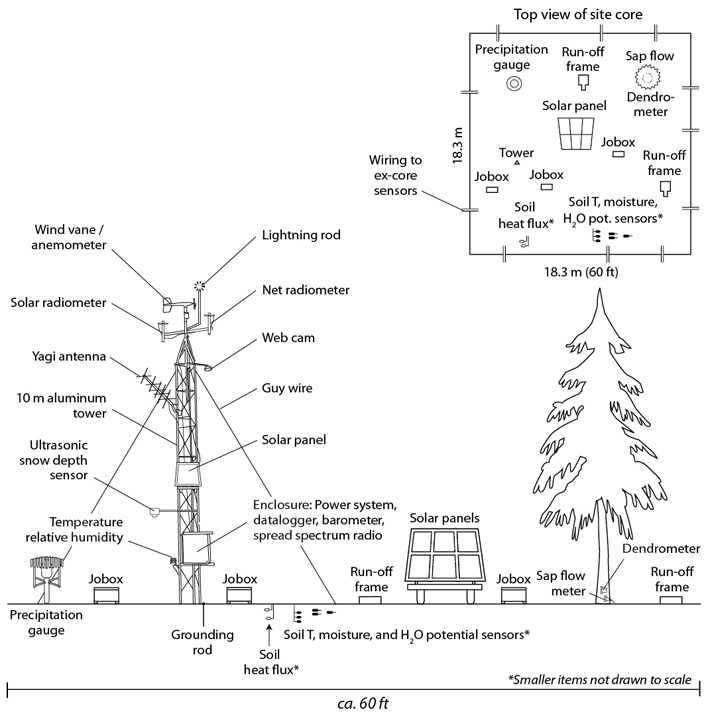NevCAN
Equipment and Sensor Overview

Cross sectional schematic of standard instrumentation installed at each transect site. A forested site is pictured here.
The equipment and sensors that make up each site of the elevational transects have been selected to monitor major hydrologic fluxes/flows and stocks, as well as key modulating ecological factors, processes and stocks. Each transect site is instrumented with a common set of equipment and sensors. At lower elevation, non-forest sites,all sensors are mounted on a 10 m guyed tall meteorological tower (UT30 Tower,Campbell Scientific Inc., Logan, UT). At higher elevation forested sites, the 10 m tower is placed in a forest gap to measure wind speed and direction, PAR, total solar radiation, and precipitation. The solar panels providing the majority of the station power are mounted on separate support legs near the towers.
Each monitoring station is located within an approximate 100 x 100 m (one hectare) homogeneous area. One hectare (a) allows complete and accurate representation of the plant communities found at each elevation, with multiple repetition of plant community units; (b) is an appropriate scale for modeling purposes that rely upon satellite data and other gridded data; and (c) provide sufficient space for establishing replicated experimental plots for future studies (e.g., precipitation treatments including irrigation or rain-out shelters; snow removal/addition treatments; simulated aerosol deposition on snow surfaces).
Data measured at each site are collected via sensors hard-wired to Campbell Scientific Inc. multiplexers and data logger(s). These data are then transmitted in real time via a Free-Wave spread spectrum radio (e.g., 900 MHz) to nearby base stations of either UNR’s seismological broadband network/microwave backbone (Sheep Range transect) or via a radio link built between the lower elevation sites in the Snake Range transect and the highest elevation site that transmits data to a base station antenna located at Great Basin College in Ely, Nevada. All data is eventually transmitted to the data portal constructed by EPSCoR’s cyber infrastructure group. The data portal provides public access to real time and archived data as well as general information about the project.
Sensors at each tower location are being used to continuously track a number of variables, meterological, abiotic and biotic (listed below) that not only enable assessment of climate variability, but more importantly provide information on hydrological and ecological response to climate variability. For example air temperature and air relative humidity (Campbell HMP50, manufactured by Vaisala) are being measured that allow calculation of evaporative demand of the air (vapor pressure deficit, VPD, a factor that strongly influences leaf stomatal conductance and transpiration, Bunce 1982; Oren et al. 1999; Körner 1994). Other variables measured include:
- Precipitation: One Geonor (Geonor Inc., T-200) vibrating wire precipitation gauge is installed in an open area at high elevation sites to continuously measure rain and snowfall. An ultrasonic snow depth sensor (Judd Communications USD) has been placed next to the Geonor gage to more thoroughly assess snow depth as well as comparability of the two snow measurements. One conventional tipping bucket rain gauge (Campbell Scientific Inc., TB4) is also installed at each site.
- Plant canopy interception of snow: To measure snow interception, graduated snow stakes (e.g., sturdy 3 m long wooden or metal stakes marked every 5 cm along each stake (e.g. surveyor's pole) have been installed at a number of locations around all high elevation tower locations. The programmable pan-tilt-zoom webcams (described below) are being used to photograph each stake on a daily basis.
- Soil infiltration and percolation: At each site, sensors measure baseline soil water flux or downward velocity e.g. using time domain transmissometry (Acclima TDT) installed vertically at 2-17 and 17-32 cm and horizontally at 10 and 20 cm, water matric potential (Campbell Scientific Inc., 229) installed at 20 cm and specific heat (East 30 Sensors DPHP) sensors installed at 1 and 2 cm depths.
- Subsurface soil (above bedrock) water flow: Small diameter piezometers will be advanced to bedrock at locations surrounding each tower, or in the immediate vicinity of the monitoring weirs, to estimate the potential for shallow subsurface runoff. Each piezometers will be equipped with a pressure transducer that will be independent of the datalogger used at the center of each plot. Other techniques to monitor subsurface runoff, like the use of a monitored trench (i.e., Tromp-van Meerveld and McDonnell, WRR, 2006) will be used if siteconditions allow, and if necessary to characterize this component of the water budget.
- Soil water content/stocks (volumetric): Stocks of plant available water present in the top layers of the soil vadose zone are tracked by water matric potential sensors (mentioned above; Campbell 229) and time domain reflectrometry probes (Campbell Scientific Inc., CS160) for the top 30 cm of the soil. These sensors are co-located with sap flow and point dendrometer sensors.
- Snow depth: Ultrasonic snow depth sensors (Judd Communications USD) have been installed at each site, to measure snow depth. To obtain a site-level assessment of snow depth, and snow depth distribution, the graduated snow stakes (described above) have been placed at plant and inter-shrub microsites for webcam photography of snow depth on a daily basis.
- Soil temperature and thermal flux: Copper-constantan thermocouples (Omega Engineering Inc.) were installed at 2.5, 5, 10, 20 and 50 cm soil depths to log soil temperature. Together with soil heat flux plates (Cambell Scientific Inc., HFP01SC) installed at 5 cm depth near each tower, heat transfer within the soil can be calculated.
- Solar radiation measurements: Net radiation and its components are measured with a Kipp & Zonen (CNR-1), which measures incoming long- and shortwave radiation, versus outgoing long- and shortwave radiation. Along with a pyranometer (Campbell Scientific Inc., CS300) that measures total sun and sky incoming radiation in the visible and near infrared region of the spectrum these sensors enable calculation of net radiation and surface alebo. A photosynthetic photon flux density sensor (Campbell Scientific Inc. LI190SB manufactured by LICOR) measures incoming radiation used by plants for photosynthesis. The data from this sensor enables explanation of temporal patterns in plant transpiration (as measured with a sap flow system). Coupled with the previously listed soil temperature and moisture sensor data, they provide estimation of plant water availability and quantification of critical lower levels where transpiration is greatly affected(in conjunction with sap flow meters).
- To quantify responses of tree species to climate variability and to help " parameterize" paleo tree ring responses to overall "climate" (plant moisture availability), automated point dendrometers (Agricultural Electronics Corporation, APD) have been installed on selected trees at each upper elevation site. Tree diameter changes also will be used in conjunction with other measures of individual tree performance such as transpiration (measured with Dynamax TDP-30 sap flow probes) and condition (e.g. snow and rain water interception; relative canopy leaf area and canopy duration and phenology). To quantify seasonal canopy phenology (development and senescence) and size (e.g., proxy for leaf area), one ground-based NDVI sensor (Skye Instruments, two channel light sensor) above each of target plant representing each site.
- At most sites (that meet method-required slope and soil texture thresholds), runoff collectors (Miller et al. 2005) are monitoring surface runoff. The rate of water flowing into the gauge will be used to calculate hillslope overland water flow.


